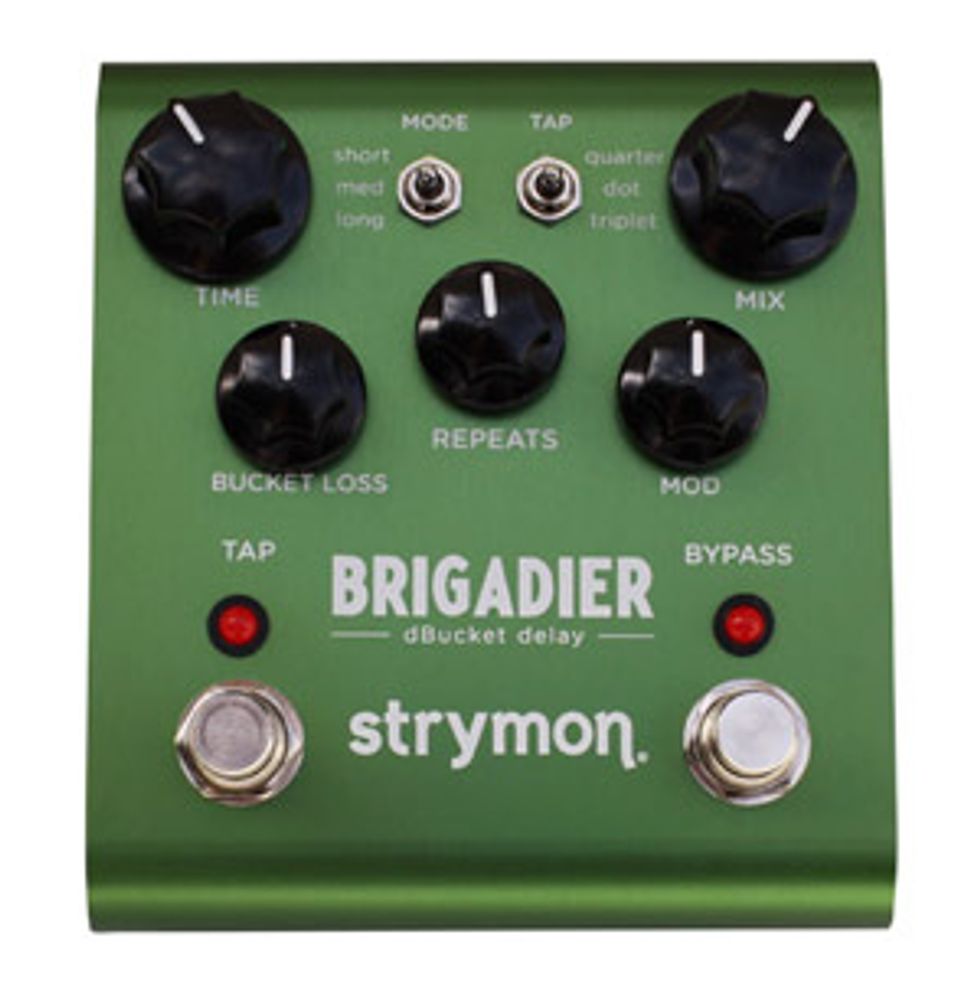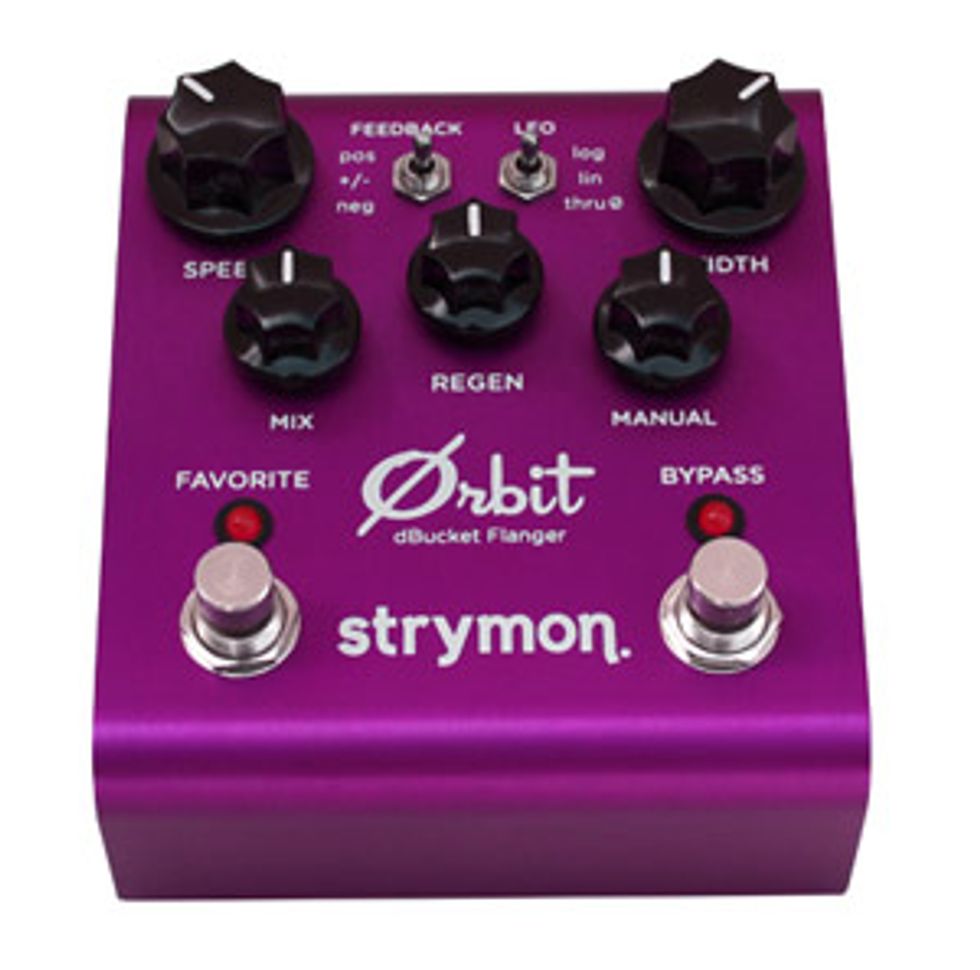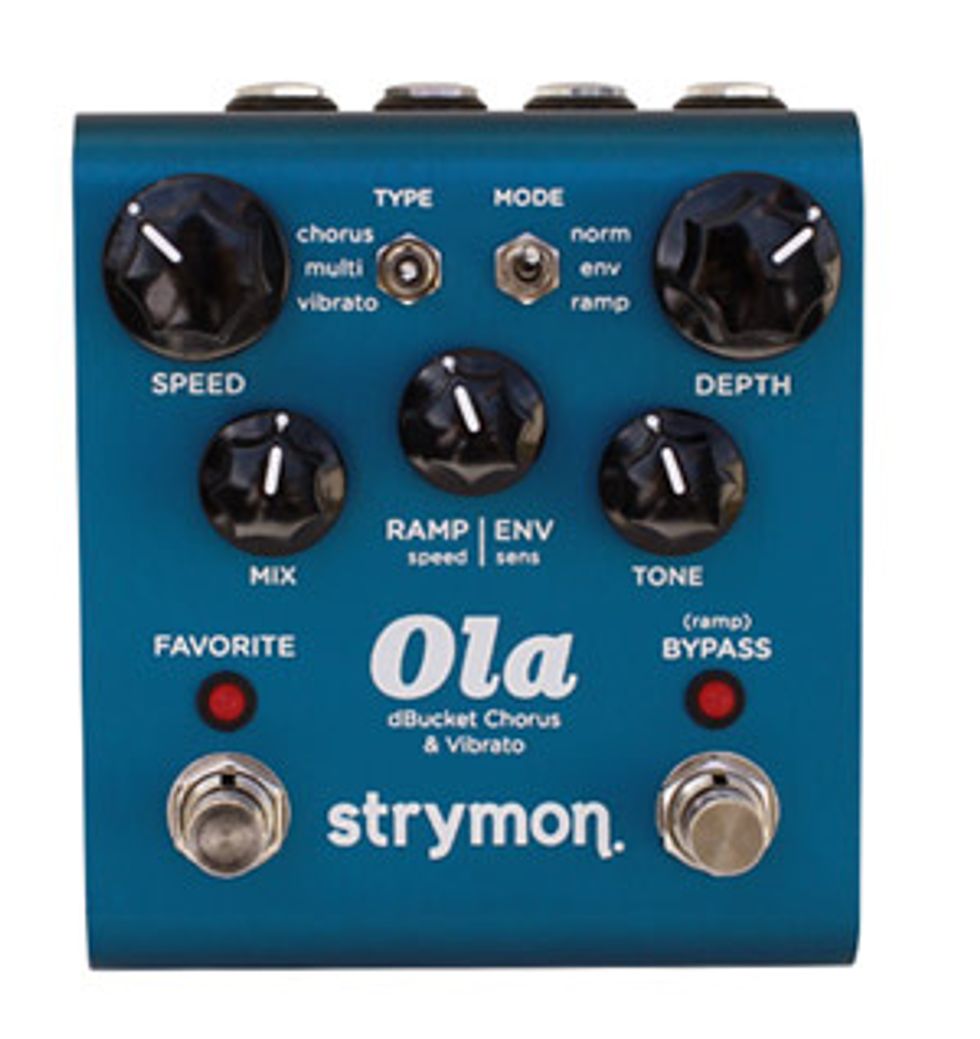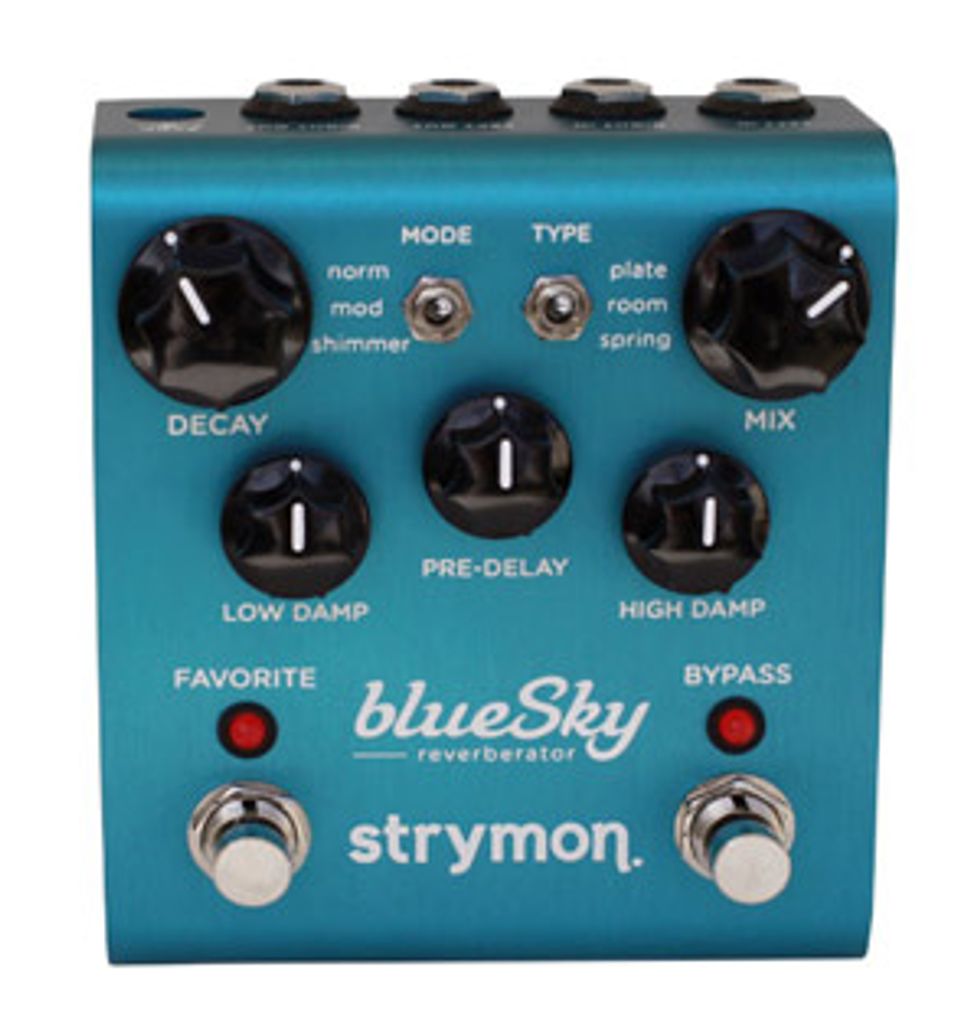Strymon Brigadier Delay, Orbit Flanger, Blue Sky Reverberator, and Ola Chorus & Vibrato Pedal Reviews
Four new pedals from Strymon combine old and new technology to recreate vintage-style sounds without the pitfalls.
Most of us can remember the first piece of
gear that made a lasting impression—whether
it was an old Strat in a pawnshop or a
classic Marshall calling from across the room.
For me, it was an old Ibanez AD9 Analog
Delay—its warm sound and funky look drew
me in immediately. But it was a temperamental
beast, and that’s an understatement.
The delay time was way too short because
of its older “bucket brigade” chips, which
were also used in the other analog delays of
the period, like the Boss DM-2 and Electro-
Harmonix Memory Man. The bucket brigade
term came about because of how the echoed
signal was produced. The signal was passed
from one capacitor to another like buckets
being passed man to man in early firefighting
brigades. Even though these chips
sounded great, the delay time was usually
very short because, as the signal was passed
from one capacitor to another, clarity was
lost. Adding more capacitors would have alleviated
this issue, but at the cost of fidelity.
Strymon seeks to correct these headaches
with a combination of modern and old-school
technologies. Their aim was to design a
digital chip that recreates the entire analog
bucket-brigade chip—tonal nuances and
all—and that drastically increases delay time.
Strymon calls the technology dBucket, and
they’re using it in three of their five pedals in
an attempt to combine the best of the analog
and digital worlds. Here we’ll take a look
at all three dBucket pedals—the Brigadier
Delay, the Orbit Flanger, and the Ola Chorus
& Vibrato—as well as the gorgeous-sounding
Blue Sky Reverberator. Each features an
attractive, anodized-aluminum case, front
panel jacks, and a 9-volt DC adapter socket.
Brigadier dBucket Delay
 | |
| Download Example 1 Long Delay, No Bucket Loss, Min Mod | |
| Download Example 2 Short Delay, 3/4 Bucket Loss, Max Mod | |
| Clips recorded with PRS McCarty DC245 20th Anniversary into a Matchless Avalon 35 combo. | |
To test the Brigadier, I used a Nick Huber Orca singlecut and a Vox AC30 reissue with the reverb switched off. With all knobs at noon, Mode set to medium, and Tap set to quarter notes, the Brigadier immediately showed what it was capable of, tonally. The pedal’s delay tone isn’t a dead-on representation of an old analog delay, but it has strengths beyond its analog ancestors. One of the biggest frustrations of older analog delays is how dull they can sound in a mix. The Brigadier has that cool, lo-fi vibe, but with a much stronger, healthier projection in its repeats. Even with the Bucket Loss control cranked to maximum, the delay tone was much more vibrant than most vintage and vintage-reissue analog delays I’ve come across. In their quest to craft a delay that captures prized analog tones while remedying their faults, Strymon seems to have come across a distinctive new sound. And the more I dug into the strings to push the envelope of clean fidelity, the more I was convinced that was the case. There are lots of analog delay modelers on the market, but most of them don’t provide the feel of playing a true analog delay. The Brigadier nails it. you’re in the market for a fantastic digital delay with a unique analog voice.
Buy if...
you’re in the market for a fantastic digital delay with a unique analog voice.
Skip if...
you’re after a softer analog delay tone with a mushier voicing.
Rating...
Direct $299 - Strymon - strymon.net |
Orbit dBucket Flanger
 | |
| Download Example 1 Half Regen, 3/4 Manual, Pos Feedback, Lin LFO | |
| Download Example 2 Hi Regen, Max Manual, Neg Feedback, Log LFO | |
| Clips recorded with PRS McCarty DC245 20th Anniversary into a Matchless Avalon 35 combo. | |
But the three-position LFO switch is the Orbit’s coolest control. It selects between a logarithmic sweep (even frequencies), a linear sweep (which speeds up through the high bands and slows down through the lower ones), and Thru 0, which phases in and out of high and lower fidelities. Fittingly, you can save your favorite setting by holding down the Favorite footswitch, and you recall it by simply stomping on the switch again. You can also use the Favorite switch to assign the expression pedal. Hold it down while plugging in the pedal, and the first knob you turn is the one the expression pedal will govern. That means any control can be assigned to the expression pedal, which opens up the possibilities for morphing from subdued to wild even further.
For my tone testing, I warmed up the Vox AC30 reissue once more and pulled out a Fender Road Worn Telecaster. With the knobs at noon, Feedback set to positive, and LFO set to logarithmic, I achieved a fairly convincing early-’80s flange tone. The Speed and Regen controls are highly sensitive, yet what really opens up the potential is the combination of the Width, Feedback, and LFO controls. Using the switches in tandem with moderate changes in Width can dramatically change the response, tone, and feel. I like my flange to have a lot of air and movement, but not be too overbearing. The negative position on the Feedback switch adds a lot of quack, which is perfect for funk styles, but I was able to quickly cut it out by flipping to the smoother sweep located in the positive position. For a wider tone, I liked setting LFO to the logarithmic position. When LFO is set to linear, the Orbit lends itself to more aggressive flanging tones, a la Smashing Pumpkins and early ’90s grunge. For players who like heavy distortion and a subtle flange sound (think My Bloody Valentine’s Kevin Shields, who is a master of using flangers and phasers to belch out a seasick wave of sound) the Thru 0 position is perfect.
Buy if...
you need an all-in-one device to satisfy your flanging jones.
Skip if...
you need something simple or your flanging needs are negligible.
Rating...
Direct $299 - Strymon - strymon.net |
Ola dBucket Chorus & Vibrato
 | |
| Download Example 1 Half Tone, 3/4 Depth, Chorus Type, Normal Mode, Half Speed | |
| Download Example 2 Half Tone, Half Depth, Max Mix, Vibrato Type, Norm Mode, Half Speed | |
| Clips recorded with PRS McCarty DC245 20th Anniversary into a Matchless Avalon 35 combo. | |
In addition to the chorus mode, two more modulation types can be selected with the Type switch: Multi is a three-phase multi-delay chorus (as opposed to the standard single delay) that avoids the warble associated with older analog chorus pedals, and the last is for vibrato. The Mode control is unique in that its effect varies depending on your playing style. In the envelope position, the circuit reacts to your pick attack. The lower you set the Ramp|Env knob, the harder you have to pick to hear the effect (kind of like how a noise gate’s Threshold knob works). In the ramp position, the effect is only activated when you hold down the footswitch. Imagine playing a solo or a single-note riff and throwing in a little fast vibrato for only one or two notes. It’s a useful feature that inspired some pretty creative moments when I was playing around with it. Mode’s ramp and env modes can be tailored with the Ramp|Env knob. With Mode set to ramp, the speed of the effect increases the further clockwise you turn Ramp|Env. With Mode set to env, the envelope opens with less pick attack the more you crank Ramp|Env. Because the pedal is so versatile, the Favorite footswitch is included here, too, so you can save your go-to setting.
Buy if...
you need a feature-laden chorus and vibrato pedal with classic tones.
Skip if...
you want the added versatility of having separate chorus and vibrato pedals
Rating...
Direct $299 - Strymon - strymon.net |
The Blue Sky Reverberator
 | |
| Download Example 1 3/4 Low Damp, 3/4 High Damp, Norm Mode, Plate Type | |
| Download Example 2 No Low Damp, Half High Damp, Shimmer Mode, Room Type | |
| Clips recorded with PRS McCarty DC245 20th Anniversary into a Matchless Avalon 35 combo. | |
Using a Nick Huber Orca into a Quidley 22 head and Quidley 2x12, I gave the spring reverb sound a run with Mode set to normal, Pre-Delay at minimum (so I could hear the reverb immediately after striking the strings), and all other knobs set at noon. I was pleased to hear that there were no latency issues, and even more pleased to hear how great the spring algorithm sounded. More importantly, I was astounded at how accurately the Reverberator interpreted my pick attack. Picking softly summoned a softer, subtler reverb than when I picked harder. The squeaking and squealing noises that a good spring reverb gives off when you dig in were also there, and they had a very authentic feel. I could hear the emulated springs shake and quiver louder and more violently the harder I picked, especially when palm muting.
After flipping to the room type, I turned Pre-Delay to 10 o’clock and dumped some of the low end using the Low Damp knob. This was especially useful when the Orca’s humbuckers pumped out some overbearing bass frequencies. What was really impressive about the room setting was its range. Using the Low Damp and High Damp controls in conjunction with the Decay and Pre-Delay knobs made it easy as pie to design a convincing emulated room, whether it was a carpeted basement or a concert hall.
The plate type is the darkest-sounding of the three, and it’s perfect for Ennio Morricone-style single-note riffs. When you use plate with the mod Mode setting, you get a much eerier mood. It would have been nice I could have altered the modulation, though. There are no controls for modulation speed or depth, so you’re pretty much stuck with one voicing. It’s a great, usable sound, but I would have liked to be able to slow the rate down a little.
Shimmer mode, on the other hand, leaves nothing to be desired. The upper octave crept in ever so slightly when I was playing either chords or single notes, and using it with the spring setting yielded my favorite sounds of all. Playing with the Mix and High Damp controls maxed out was ghostly soundscape heaven—just the thing for guitarists from the Robert Fripp school. The effect is almost like a volume swell. When used with the room reverb, it’s very reminiscent of the long-discontinued (but very coveted) Boss PS-3 Pitch Shifter in mode 7. In fact, I like the Blue Sky’s shimmer mode even because you can dial in just the right amount of highs and lows.
Buy if...
you’re looking for an extraordinary, compact reverb.
Skip if...
your reverb needs are simple or your amp’s built-in reverb gets the job done.
Rating...
Direct $299 - Strymon - strymon.net |

